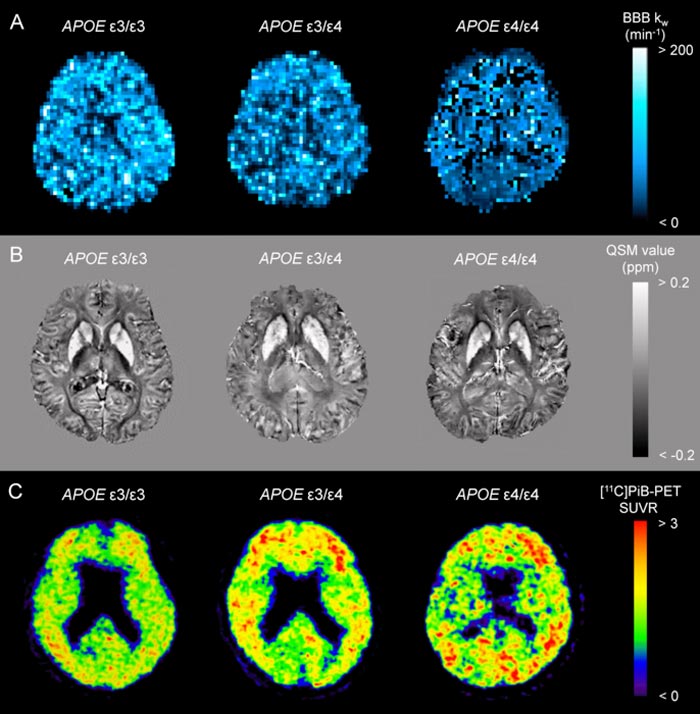A new biomarker for blood–brain barrier dysfunction in Alzheimer’s disease

BBB kw map (A), QSM (B), and [11C]PiB-PET SUVR (C) from an APOE ɛ4 noncarrier (ε3/ε3), a heterozygote (ε3/ε4), and a homozygote (ε4/ε4) are displayed.
Credit: Nagoya City Unviersity
An advanced MRI and PET study…
Alzheimer’s disease (AD) is the most common type of dementia. An etiology of AD would be excessive accumulation of toxic forms of β-amyloid (Aβ), assumed to result from an imbalance between its production and clearance. Individuals with early-onset AD-related gene mutations show both increased production and decreased clearance of Aβ, whereas those with late-onset AD, which accounts for > 95% of cases, exhibit only decreased Aβ clearance.
The ε4 allele of APOE gene is the strongest and most validated genetic risk factor for late-onset AD. Previous research has shown that carrying one APOE ε4 allele (heterozygotes) increases the risk of late-onset AD 3–4-fold, and carrying two APOE ε4 alleles (homozygotes) increases the risk 9–15-fold. Considering the prevalence and risk-determining effect, an improved understanding of APOE ɛ4-related pathophysiology will aid the development of novel therapeutic strategies for late-onset.
Emerging evidence suggests that APOE ɛ4 directly impairs the blood–brain barrier (BBB), a highly selective semipermeable border formed by capillary endothelial cells, astrocytic end-feet, and pericytes. Astrocyte-secreted ApoE4 induces the degeneration of brain capillary pericytes that maintain BBB integrity, and individuals carrying APOE ɛ4 show BBB dysfunction leading to cognitive decline, independent of AD pathology.
The current study aimed to verify the influence of APOE ɛ4 on effective BBB clearance, evaluated using an advanced magnetic resonance diffusion-prepared arterial spin labeling (DP-ASL) technique. An appealing feature of the DP-ASL technique is its non-invasive nature and ability to quantitatively estimate water exchange rate across the BBB (kw index) using a conventional 3.0-T MRI system.
First, we presented the clinical characteristics and neuropsychological scores for APOE ɛ4 noncarrier, heterozygous, and homozygous groups from the early stages of the Alzheimer’s continuum cohort. Second, we compared AD-related imaging biomarkers, including the BBB kw map, quantitative susceptibility mapping (QSM), [11C]Pittsburgh compound B-positron emission tomography (PiB-PET), and cortical thickness. Finally, we assessed the correlation of kw values with neuroimaging metrics of AD pathology and neuropsychological scores. We concluded that APOE ɛ4 dose would be associated with poor brain-waste clearance through the BBB, causing brain iron and Aβ accumulation.
Journal: Journal of Neurology
DOI: 10.1136/jnnp-2021-328519
Method of Research: Imaging analysis
Subject of Research: People
Article Title: APOE ɛ4 dose associates with increased brain iron and β-amyloid via blood–brain barrier dysfunction
Article Publication Date: 28-Apr-2022
All latest news from the category: Life Sciences and Chemistry
Articles and reports from the Life Sciences and chemistry area deal with applied and basic research into modern biology, chemistry and human medicine.
Valuable information can be found on a range of life sciences fields including bacteriology, biochemistry, bionics, bioinformatics, biophysics, biotechnology, genetics, geobotany, human biology, marine biology, microbiology, molecular biology, cellular biology, zoology, bioinorganic chemistry, microchemistry and environmental chemistry.
Newest articles

Innovative 3D printed scaffolds offer new hope for bone healing
Researchers at the Institute for Bioengineering of Catalonia have developed novel 3D printed PLA-CaP scaffolds that promote blood vessel formation, ensuring better healing and regeneration of bone tissue. Bone is…

The surprising role of gut infection in Alzheimer’s disease
ASU- and Banner Alzheimer’s Institute-led study implicates link between a common virus and the disease, which travels from the gut to the brain and may be a target for antiviral…

Molecular gardening: New enzymes discovered for protein modification pruning
How deubiquitinases USP53 and USP54 cleave long polyubiquitin chains and how the former is linked to liver disease in children. Deubiquitinases (DUBs) are enzymes used by cells to trim protein…



